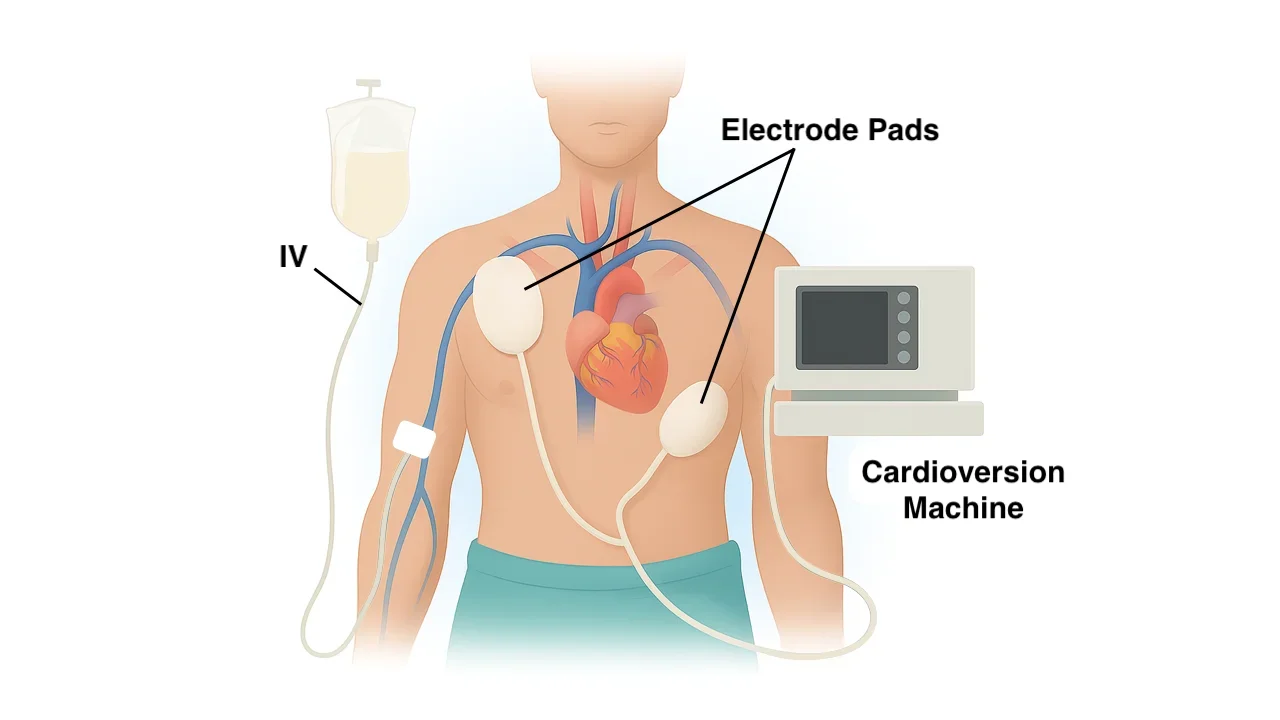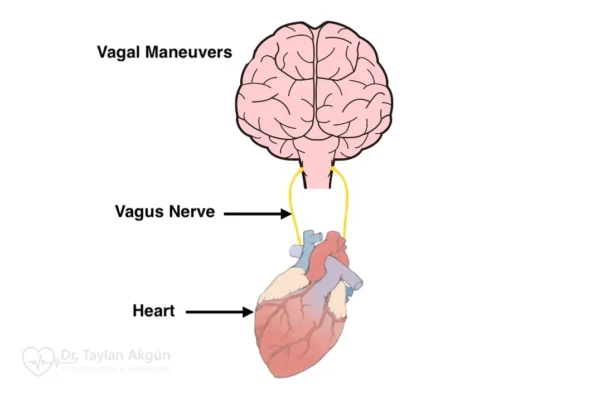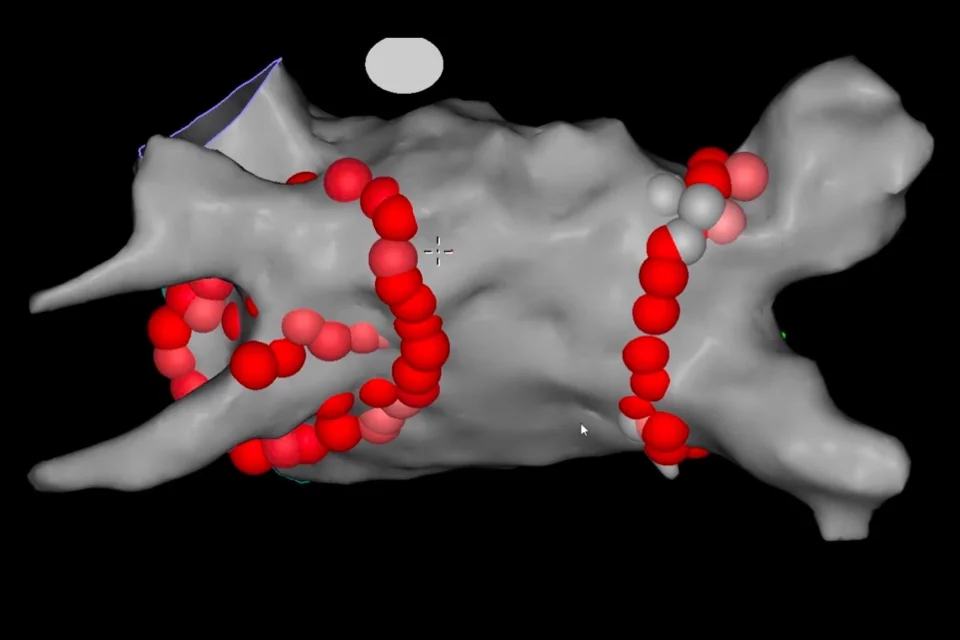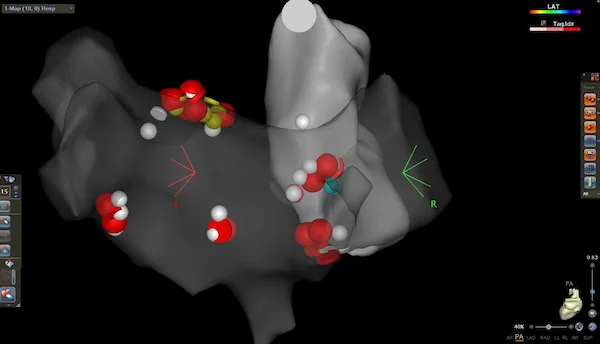When your heart develops an abnormal rhythm that won’t stop on its own, cardioversion offers a way to reset it back to normal. This procedure uses either medication or a controlled electrical shock to interrupt the irregular rhythm and allow your heart’s natural pacemaker to take over again. While the idea of shocking your heart might sound dramatic, cardioversion is a routine, safe procedure performed thousands of times daily in hospitals worldwide.
Overview
Cardioversion is a medical procedure that converts an abnormal heart rhythm back to normal sinus rhythm. The goal is simple: stop the irregular rhythm and restore the organized, coordinated heartbeat your heart should have.
There are two types of cardioversion based on how the rhythm is reset. Electrical cardioversion uses controlled electrical shocks delivered through paddles or patches placed on your chest. The shock briefly stops all electrical activity in your heart, allowing your natural pacemaker to resume control. Chemical or pharmacological cardioversion uses medications given through an IV or by mouth to restore normal rhythm without electrical shocks.
Cardioversion is used for various rhythm problems. Atrial fibrillation, where the upper chambers beat chaotically, is the most common reason for the procedure. Atrial flutter, where the upper chambers beat very rapidly in an organized pattern, also responds well to cardioversion. Some types of rapid heartbeat from the lower chambers can be treated this way, though these are often more concerning and require urgent treatment.
The procedure differs from defibrillation, though they’re related. Defibrillation uses higher energy shocks for life-threatening rhythms like ventricular fibrillation during cardiac arrest. Cardioversion uses lower energy, synchronized shocks for less dangerous but still problematic rhythms, and you receive sedation so you’re unconscious during the procedure.
Cardioversion is highly effective at restoring normal rhythm, with success rates often exceeding 90% for the actual procedure. However, success in maintaining normal rhythm afterward varies considerably. Some people stay in normal rhythm indefinitely, while others quickly return to the abnormal rhythm. This is why cardioversion is often combined with medications to help maintain normal rhythm.
The procedure itself is quick, usually taking only minutes once you’re sedated. However, preparation beforehand and monitoring afterward mean you’ll spend several hours at the hospital.
Why You Might Need One
Cardioversion is recommended when an abnormal heart rhythm causes problems and won’t convert back to normal on its own.
- Atrial fibrillation is the most common reason for cardioversion. If you develop atrial fibrillation for the first time, particularly if it’s causing significant symptoms, cardioversion gives you the best chance of returning to normal rhythm. Even people with longstanding atrial fibrillation might undergo cardioversion to see if maintaining normal rhythm improves their symptoms and quality of life.
- Persistent rapid heartbeat that doesn’t respond to medications might require cardioversion. If your heart is beating 140-180 beats per minute from atrial flutter or another rhythm and medications haven’t slowed it down, cardioversion quickly restores normal rate.
- Severe symptoms from abnormal rhythms make cardioversion urgent. If irregular rhythm is causing chest pain, severe shortness of breath, dangerous blood pressure drops, or signs that your heart can’t pump effectively, cardioversion is performed promptly.
- Some people feel much worse with irregular rhythm than they realized. They’ve adapted gradually to atrial fibrillation over months or years and don’t recognize how poorly they feel until normal rhythm is restored. For these people, cardioversion reveals how much better they can feel, motivating efforts to maintain normal rhythm.
- Younger patients with new onset atrial fibrillation are often good cardioversion candidates. Restoring normal rhythm early and maintaining it with medications might prevent the rhythm problem from becoming permanent.
- Before certain heart procedures, cardioversion might be performed to optimize your heart function. For example, if you need surgery and have atrial fibrillation, converting to normal rhythm beforehand can reduce surgical risks.
However, cardioversion isn’t appropriate for everyone. If you have permanent atrial fibrillation that’s been present for many years, particularly if your heart has enlarged significantly, cardioversion is unlikely to succeed long-term. If you have frequent episodes that keep recurring despite multiple cardioversions, other treatments like catheter ablation might be better options.
Before the Procedure
Preparing for cardioversion involves several important steps, primarily to prevent blood clots from causing strokes.
- Blood clot prevention is the most critical aspect of preparation. When your heart is in abnormal rhythm, particularly atrial fibrillation or flutter, blood can pool in the upper chambers and form clots. If cardioversion is performed with clots present, the sudden return to normal rhythm can dislodge these clots, sending them to your brain and causing stroke.
- For elective cardioversion, you’ll typically take blood thinners for at least three weeks before the procedure. This allows any existing clots to dissolve. You’ll continue blood thinners for at least four weeks after cardioversion because clot risk remains elevated even after rhythm is restored. Some people need lifelong blood thinners depending on their stroke risk factors.
- If cardioversion is urgent and can’t wait three weeks, a transesophageal echocardiogram may be performed. This test uses an ultrasound probe passed down your esophagus to get detailed images of your heart’s upper chambers, looking for clots. If no clots are seen, cardioversion can proceed safely with appropriate blood thinning started immediately.
- Fasting is required. You’ll be instructed not to eat or drink anything after midnight before your procedure, or for at least six hours beforehand. This is because you’ll receive sedation, and having an empty stomach reduces risks.
- Medication instructions vary. Some heart medications should be taken the morning of cardioversion with a small sip of water, while others should be held. Your doctor provides specific guidance. If you take diabetes medications, special instructions apply since you’ll be fasting.
- Arrange transportation. You’ll receive sedation that affects your thinking and reflexes for several hours. You cannot drive yourself home and need someone to stay with you for several hours after the procedure.
- Bring a list of all medications you take, including doses. Also bring your blood thinner medication card if you have one.
- Plan to spend several hours at the hospital. While the procedure itself is brief, preparation and recovery monitoring take time. Most people go home the same day.
The Procedure
Cardioversion takes place in a hospital, usually in a procedure room, cardiac catheterization lab, or sometimes the emergency department.
- You’ll change into a hospital gown and lie on a bed or procedure table. Nurses place electrodes on your chest to monitor your heart rhythm continuously and establish an IV line for medications.
- For electrical cardioversion, patches or paddles are positioned on your chest. The most common placement is one patch on your right chest near your collarbone and another on your left side below your ribs. Sometimes patches are placed front and back. The exact positioning depends on your specific rhythm problem.
- The medical team connects you to monitoring equipment tracking your heart rhythm, blood pressure, and oxygen levels throughout the procedure.
- Before the shock is delivered, you receive sedation through your IV. This medication makes you unconscious for several minutes so you don’t feel the shock. Most people remember nothing about the actual cardioversion. Common sedatives include propofol, which works very quickly but also wears off quickly, or other medications like midazolam combined with fentanyl.
- Once you’re sedated and unconscious, the doctor delivers the electrical shock. The machine synchronizes the shock with your heartbeat to avoid delivering it at a dangerous moment. The energy level typically starts relatively low, often 50-200 joules depending on the rhythm being treated. Your body might jerk slightly from the electrical current, but you’re unaware of this.
- The team immediately checks your heart rhythm to see if it converted to normal. If not, they may increase the energy and deliver another shock. Most cardioversions succeed within one to three shocks. The entire shocking process takes only seconds.
- For chemical cardioversion, no electrical shocks are used. Instead, you receive medication through your IV or by mouth. You remain awake during chemical cardioversion. The medication works over minutes to hours, and you’re monitored continuously to see when and if rhythm converts. This approach is less predictable than electrical cardioversion but avoids the need for sedation.
- After successful electrical cardioversion, you wake up quickly, usually within minutes as sedation wears off. You might feel confused briefly, but this passes. The sedation makes most people forget the entire procedure.
What to Expect During the Procedure
For electrical cardioversion, your experience centers on the sedation rather than the cardioversion itself.
- Before sedation, you’re awake and aware. Nurses are busy preparing equipment, placing monitoring devices, and ensuring everything is ready. The room might feel cold because procedure rooms are kept cool. You might feel anxious, which is completely normal.
- As sedation medication flows through your IV, you feel it working within seconds. Most people describe feeling relaxed, then sleepy, then nothing. You won’t feel the electrical shock at all. You’re completely unconscious during the critical moment.
- The actual shock lasts a fraction of a second. Observers might see your body jerk or muscles twitch, but you experience none of this. From your perspective, you close your eyes as sedation takes effect and open them moments later with the procedure complete.
- Waking up feels similar to waking from a brief nap. You might feel groggy or confused for a few minutes. Some people don’t remember the moments just before sedation or just after waking, which is normal. This amnesia is actually a helpful effect of the sedation medications.
- Your chest might feel slightly sore where the patches were placed, similar to minor sunburn. This discomfort is mild and temporary.
- For chemical cardioversion, you remain awake throughout. You might feel nothing as the medication works, or you might notice when your rhythm converts. Some people feel a brief flutter or change in their heartbeat when normal rhythm returns. The waiting can feel long since chemical cardioversion takes much longer than electrical cardioversion.
After the Procedure
Recovery from cardioversion involves monitoring to ensure your heart stays in normal rhythm and you recover fully from sedation.
- Immediately after electrical cardioversion, you remain in the recovery area with continuous heart monitoring. Nurses check your vital signs frequently, watching for any return of abnormal rhythm or complications. Most people stay for at least one to two hours, sometimes longer.
- The sedation effects wear off gradually over one to two hours. Initially, you might feel sleepy, slightly confused, or unsteady. These effects fade as the medication clears your system. Some people feel completely normal within 30 minutes, while others need longer.
- You can usually eat and drink once you’re fully awake. There are no dietary restrictions related to the cardioversion itself.
- Your chest might be slightly red or tender where patches were placed, like mild sunburn. This resolves within a day or two. Applying aloe or moisturizer helps if skin feels irritated.
- Before discharge, your heart rhythm is checked one final time to confirm you’re still in normal rhythm. You’ll receive instructions about medications, activity restrictions, and warning signs to watch for.
- You cannot drive for 24 hours after receiving sedation, even if you feel fine. Your judgment and reflexes remain impaired longer than you realize. Someone must drive you home and ideally stay with you for several hours.
- Activity restrictions are minimal. You can resume normal light activities immediately but should avoid strenuous exercise for 24 hours. This allows your heart to stabilize in its new rhythm.
- Medication adjustments often occur after cardioversion. Your doctor might start or change medications to help maintain normal rhythm. Blood thinners typically continue for at least four weeks, often longer depending on your stroke risk factors.
- Most people go home the same day. Overnight hospital stays are rare and usually only for those with complications or other medical issues requiring continued monitoring.
Recovery and Follow-up
Recovery from cardioversion is generally quick and straightforward.
- The first 24 hours after cardioversion are most critical for rhythm monitoring. Your heart might slip back into abnormal rhythm during this period. Some doctors provide a heart monitor to wear at home for 24-48 hours after the procedure to catch any immediate recurrence.
- Rest on the day of cardioversion. While you can resume light activities, avoid anything strenuous. The sedation effects might linger subtly, making you more tired than usual.
- Resume normal activities the next day if you feel well and your doctor approves. Most people return to work within one to two days.
- Take all medications exactly as prescribed. Medications to maintain normal rhythm work best when taken consistently at the same times each day. Blood thinners are crucial for preventing stroke and must not be skipped.
- Watch for return of symptoms you had before cardioversion. If you notice palpitations, irregular heartbeat, shortness of breath, or other symptoms that were present before the procedure, your rhythm might have reverted. Contact your doctor.
- Follow-up appointments are essential. You’ll typically see your doctor within one to four weeks after cardioversion to check that you’re maintaining normal rhythm and that medications are working without causing side effects. An electrocardiogram at this visit confirms your rhythm status.
- Long-term success varies widely. Some people stay in normal rhythm for years after a single cardioversion. Others revert to abnormal rhythm within days or weeks. If rhythm reverts despite medications, your doctor might try different medications, repeat cardioversion, or recommend catheter ablation to improve long-term success.
- Many people feel dramatically better after successful cardioversion. Energy levels improve, breathing becomes easier, and exercise tolerance increases. You might not have realized how poorly you felt until normal rhythm shows you how good you can feel.
Success Rates and What Affects Them
Cardioversion successfully converts rhythm to normal in 90-95% of procedures. However, maintaining normal rhythm long-term is more challenging.
For atrial fibrillation present less than 48 hours, success rates are highest. About 50-70% of people remain in normal rhythm one year after cardioversion when taking appropriate medications. For atrial fibrillation present for months or years, long-term success rates are lower, typically 20-40% at one year.
Several factors affect whether you’ll maintain normal rhythm after cardioversion. Duration of abnormal rhythm matters significantly. The longer you’ve been in atrial fibrillation or flutter, the harder it is to stay in normal rhythm after conversion. This is why cardioversion is often recommended soon after abnormal rhythm develops.
Left atrial size influences success. The upper left chamber of your heart enlarges over time when you’re in atrial fibrillation. Very enlarged atria are less likely to maintain normal rhythm after cardioversion. Echocardiography before the procedure shows chamber size and helps predict success.
Underlying heart disease affects outcomes. People with normal heart structure and function maintain normal rhythm more successfully than those with heart failure, valve disease, or other structural problems.
Medications to maintain rhythm significantly improve long-term success. Taking antiarrhythmic drugs after cardioversion doubles or triples the likelihood of staying in normal rhythm compared to cardioversion alone.
Lifestyle factors including obesity, sleep apnea, excessive alcohol use, and uncontrolled high blood pressure reduce long-term success. Addressing these issues before and after cardioversion improves your chances of maintaining normal rhythm.
Age plays a role. Younger patients generally have better long-term success rates than older patients, though age alone doesn’t determine who should undergo cardioversion.
Potential Risks and Complications
Cardioversion is very safe, but like all medical procedures, it carries some risks.
- Stroke is the most serious risk, occurring in about 1-2% of cardioversions overall. This happens if blood clots present in the heart dislodge when normal rhythm returns. Proper preparation with blood thinners for three weeks beforehand, or screening with transesophageal echocardiogram for urgent cases, reduces this risk to less than 1%.
- Skin burns from electrical pads are usually very minor, causing temporary redness or irritation. Proper pad placement and use of conducting gel minimize this risk. True burns requiring treatment are extremely rare.
- Other heart rhythm problems can occasionally develop. Sometimes the cardioversion triggers different abnormal rhythms, though these are usually temporary and treatable. Rarely, the heart might beat too slowly after cardioversion, particularly in people with underlying conduction system disease.
- Blood pressure changes can occur. Blood pressure might drop during or shortly after cardioversion, though this usually resolves quickly. Medications to support blood pressure are rarely needed.
- Sedation risks include allergic reactions to sedation medications, breathing problems during sedation, or prolonged grogginess afterward. These complications are uncommon because sedation is brief and carefully monitored.
- Failed cardioversion, where the rhythm doesn’t convert or immediately reverts, isn’t dangerous but is disappointing. This happens in about 5-10% of procedures. If cardioversion fails, your doctor might try again with higher energy, use different pad positions, or recommend alternative treatments.
- Quick return to abnormal rhythm is frustrating but not harmful. Some people revert within hours or days despite successful initial conversion. This suggests you need different medications or alternative treatments like catheter ablation.
When to Call Your Doctor
After cardioversion, certain situations require prompt medical attention.
- Seek emergency care if you experience symptoms suggesting stroke: sudden weakness or numbness on one side of your body, sudden difficulty speaking or understanding speech, sudden vision changes, severe headache, or sudden loss of balance. Stroke risk is highest in the first few days after cardioversion.
- Call emergency services for chest pain that’s severe, lasts more than a few minutes, or is accompanied by shortness of breath, sweating, or nausea. While cardioversion doesn’t cause heart attacks, you could be having one.
- Contact your doctor promptly if symptoms you had before cardioversion return. Palpitations, irregular heartbeat, shortness of breath, or dizziness suggest your rhythm may have reverted to abnormal. An electrocardiogram can confirm this.
- Report unusual bleeding if you’re taking blood thinners. This includes blood in urine or stool, unusually heavy menstrual bleeding, severe nosebleeds, or excessive bruising. While some increased bleeding tendency is expected with blood thinners, excessive bleeding needs evaluation.
- Notify your doctor if you develop fever or increasing pain, redness, or swelling at the IV site. These could indicate infection.
- If you feel extremely tired, dizzy, or faint, particularly if your heart rate seems very slow, contact your doctor. Occasionally, cardioversion reveals underlying problems with slow heart rates that were masked by the rapid abnormal rhythm.
- Report medication side effects. Antiarrhythmic drugs used to maintain normal rhythm can have various side effects, and your doctor needs to know about these to adjust treatment appropriately.
Key Points
- Cardioversion is a safe, effective procedure for restoring normal heart rhythm when abnormal rhythms don’t convert on their own. The procedure itself is brief and well-tolerated because you’re sedated during electrical shocks.
- Preventing stroke with adequate blood thinning before and after cardioversion is crucial. This preparation period, typically three weeks before and four weeks after, is essential for safety even though it delays the procedure.
- Success in converting rhythm during the procedure is high, but maintaining normal rhythm long-term is more challenging. Medications, lifestyle changes, and addressing underlying conditions all improve your chances of staying in normal rhythm.
- Cardioversion isn’t a one-time cure for most people. Many need ongoing medications to maintain rhythm, and some eventually revert to abnormal rhythm despite treatment. This doesn’t mean cardioversion failed—it provided a period of normal rhythm that might have improved symptoms and heart function.
- The decision to undergo cardioversion should consider your symptoms, overall health, likelihood of maintaining normal rhythm, and personal preferences. Some people feel dramatically better in normal rhythm and want to pursue every option to maintain it. Others tolerate abnormal rhythm well and prefer simpler management with rate control medications.
- Cardioversion is often a stepping stone to other treatments. If you respond well but keep reverting to abnormal rhythm, this suggests catheter ablation might be more definitive. If cardioversion fails or rhythm reverts immediately, this helps guide decisions about alternative approaches.
- Most people who undergo cardioversion, particularly for new onset atrial fibrillation, find it worthwhile. Even if normal rhythm doesn’t last forever, the procedure provides valuable information about how much better you feel in normal rhythm and whether pursuing rhythm control with medications or ablation is worth the effort.
- Work closely with your cardiologist to understand realistic expectations for your specific situation. Factors like how long you’ve had abnormal rhythm, your heart’s structure and function, underlying conditions, and overall health all influence likely success. Understanding these factors helps you make informed decisions about cardioversion and what comes after.
You may also like to read these:
Reference: Cardioversion






